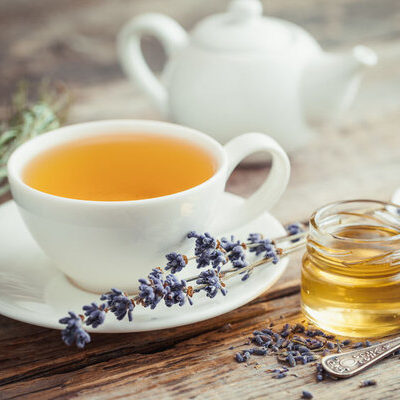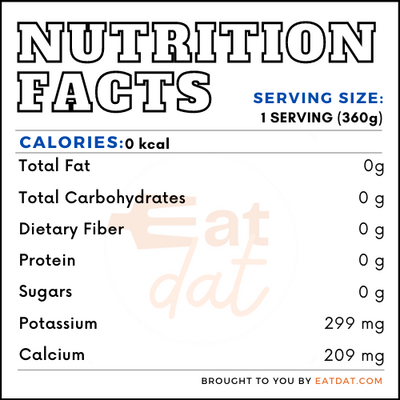
Lavender Tea
What is Lavender Tea?
Lavender tea is an herbal tea produced by mixing the fresh or dried purple buds of the lavender plant (Lavandula angustifolia) with hot water. This tea doesn’t contain any caffeine but is consumed for its soothing effects. Lavender is a plant native to North Africa and the mountainous region of the Mediterranean.
- The name “lavender” was coined from the Latin word ‘lavare’ meaning “to wash” or “to bathe.”
- The world’s biggest consumer of lavender oil is the United States.
The most popular lavender tea brands include:
- Buddha Teas
- Harney and Sons Victorian London Fog Tea
- Traditional Medicinals
- Celestial Seasonings Lemon Lavender Lane Tea
- The Republic of Tea Daily
- Pukka Herbal Love Tea
Origin of lavender tea
Lavender has been in existence for over 2,000 years. Many historians believe that the Egyptians were the first to discover it. The early Greeks learned from them, and the Romans followed suit, using it for medical purposes. During the Victorian Era, English royalty fell in love with this plant’s scent. The Queen’s interest in lavender led to its use throughout England.
In modern times, Rene Gatefosse, one of the founders of aromatherapy, rediscovered the healing properties of this tea after burning his arms in his lab. He used lavender to soothe his burn and notice that it sped up the wound’s healing. Today, lavender and its tea are enjoyed by people across the globe.
Function
The lavender flower is a valuable ingredient in baking and cooking. Some common ways of using edible lavender in the kitchen are:
- Flavoring for foods
- Garnishing salads
- Sprinkling over desserts
- Adding into a glass of wine
- Crafting marinades
Nutrition
One serving (360g) contains:

Lavender tea is popular for its many health benefits. Here are some of them:
- It improves mood by helping with depression, anxiety, and fatigue.
- The calming effects of this tea can improve sleep.
- It reduces the discomfort caused by menstrual cramps.
- This tea may boost skin health.
- It also treats common digestive issues.
However, here are a few side effects to take into consideration:
- This tea may reduce the function of the central nervous system. Thus, it is not recommended to take it before or after surgery.
- It may also irritate the skin when applied in excess.
- Drinking may lead to headaches, constipation, and increased appetite.
- It may trigger an allergic reaction for some individuals, especially those with pollen allergies
Commercial production
Lavender production is split into two sections, namely essential oil production and cut flower production or dried ornamental production. The production goal determines the variety or species cultivated. However, lavender is mainly commercially produced for its essential oil content.
The first stage of the commercial production of lavender is cultivation. Lavender grows best in well-drained loamy soil with a pH range of 6.5 and 7.5. Irrigation, fertilization, weed control, as well as pest and disease control, are responsible for the healthy growth of this plant. The next stage is harvesting, although the method varies according to the product. Hand harvesting is recommended for the buds, bundles, and fresh flowers, while mechanical harvesting works best for essential oil production.
In 2017, the global market value of lavender oil was $33.76 billion and was estimated to increase to $44.68 in the next five years. In the same year, the global market value of essential oils was $17 billion, and was estimated to reach $27 billion in the next five years. The current value of the US essential oil market is $4 billion. The annual growth rate of the American essential oil industry is 7.5%. Nonetheless, the largest global producer of lavender is Bulgaria.
Application
The steps to make lavender tea at home are straightforward. Simply boil water and allow the tea to steep in the hot water for five minutes. Then, strain the water and enjoy.
For the best tea, it’s essential to store the herb properly. Dried lavender should be stored in an airtight container or kept in a dark place with low humidity and a stable temperature. Before storing, it’s advisable to separate the blooms from the stalk.
Lavender tea recipes
This tea blends perfectly with most ingredients. Here are a few recipes to spice things up:
- Lavender Mint Tea
- Iced Lavender Green Tea
- Lavender Milk Tea
- Lavender Lemonade
- Lavender-Chamomile Herbal Tea
FDA Regulation
The Food & Drug Administration recognizes lavender as a natural seasoning spice or flavor and essential oil that is safe for the intended use. The FDA also classifies lavender oil as an active ingredient for permitted combinations for medical purposes. Furthermore, the FDA provides the standard of identity for these active ingredients.
References
Specialist, Written by Jeanine DavisExtension. “Lavender: History, Taxonomy, and Production.” Newscropsorganics.ces.ncsu.edu, NC State Extension News, newcropsorganics.ces.ncsu.edu/ /lavender-history-taxonomy-and-production/.
“Lavender: Health Benefits and Uses.” Medicalnewstoday.com, Medical News Today International, www.medicalnewstoday.com/articles/265922.
Krans, Brian. “How to Make Lavender Tea.” Healthline.com, Healthline Media, 19 Dec. 2016, www.healthline.com/health/healthy-sleep/how-to-make-lavender-tea.
“CFR – Code of Federal Regulations, Title 21.” Accessdata.fda.gov, U.S Food & Drug Administration, 1 Apr. 2019, https://www.accessdata.fda.gov/scripts/cdrh/cfdocs/cfcfr/CFRSearch.cfm?CFRPart=182&showFR=1&subpartNode=21:3.0.1.1.13.1
